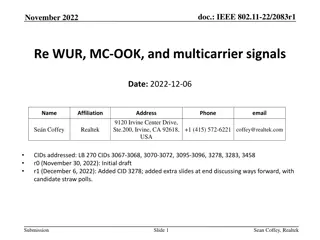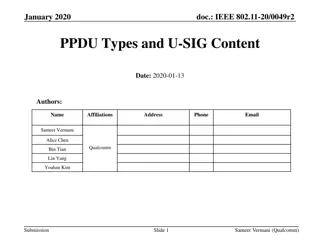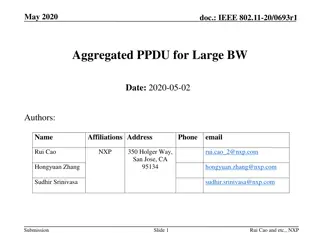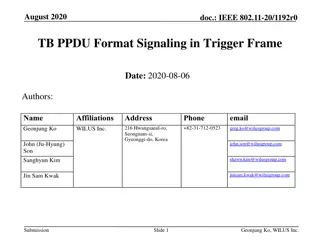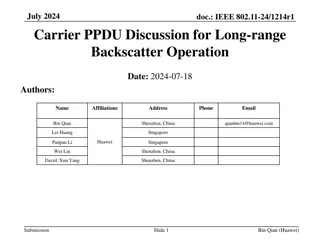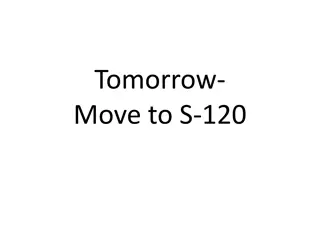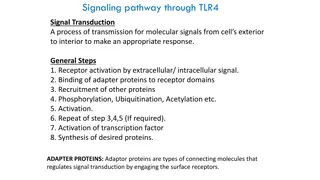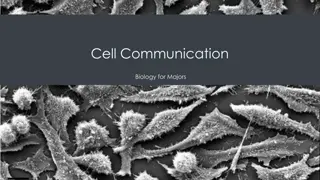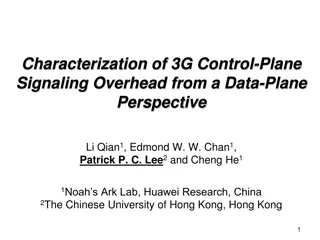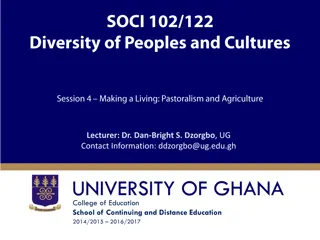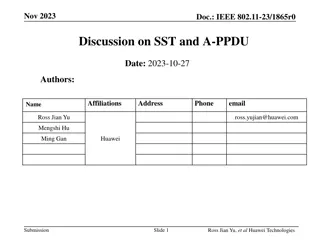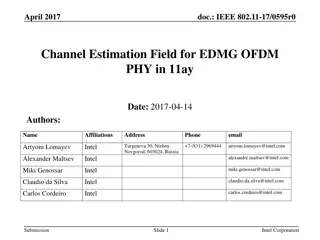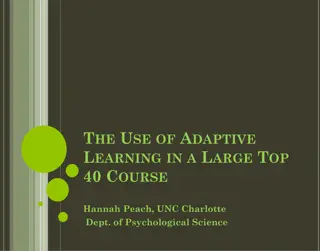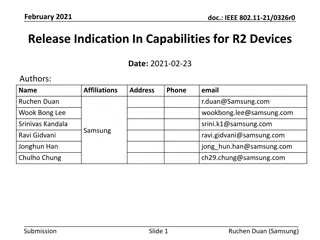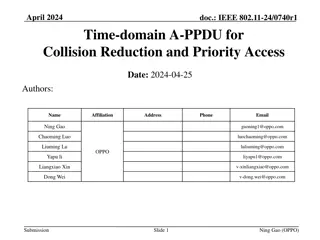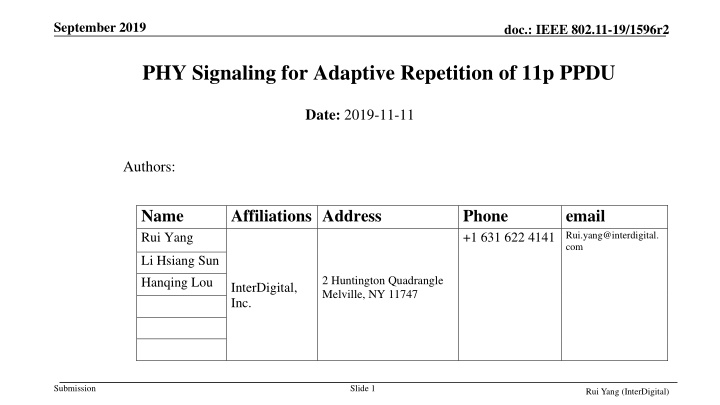
Adaptive Repetition of 11p PPDU in IEEE 802.11 Standards
Explore the innovative PHY signaling proposed by Rui Yang from InterDigital for enabling adaptive repetition of 11p PPDU in IEEE 802.11-19/1596r2 standard. Discover the benefits and motivations behind this approach, including improved performance, coexistence, and backward compatibility with 802.11p equipment. Learn about the additional subcarriers and transmission strategies discussed for enhancing communication efficiency in NGV and 802.11p stations.
Download Presentation

Please find below an Image/Link to download the presentation.
The content on the website is provided AS IS for your information and personal use only. It may not be sold, licensed, or shared on other websites without obtaining consent from the author. If you encounter any issues during the download, it is possible that the publisher has removed the file from their server.
You are allowed to download the files provided on this website for personal or commercial use, subject to the condition that they are used lawfully. All files are the property of their respective owners.
The content on the website is provided AS IS for your information and personal use only. It may not be sold, licensed, or shared on other websites without obtaining consent from the author.
E N D
Presentation Transcript
September 2019 doc.: IEEE 802.11-19/1596r2 PHY Signaling for Adaptive Repetition of 11p PPDU Date: 2019-11-11 Authors: Name Rui Yang Affiliations Address Phone +1 631 622 4141 Rui.yang@interdigital. email com Li Hsiang Sun Hanqing Lou 2 Huntington Quadrangle Melville, NY 11747 InterDigital, Inc. Submission Slide 1 Rui Yang (InterDigital)
September 2019 doc.: IEEE 802.11-19/1596r2 Introduction TGbd has agreed that [1] 11bd shall support adaptive repetition of 11p PPDU when operating on OCB broadcast mode in 10MHz bandwidth. The signaling of the adaptive repetition is TBD. The time between repeated 11p PPDUs is TBD. In this document we present a possible PHY layer signaling to enable the adaptive repetition of 11p PPDU Submission Slide 2 Rui Yang (InterDigital)
September 2019 doc.: IEEE 802.11-19/1596r2 Recap: the benefit of 11p PPDU adaptive repetition In [2], adaptive repetition of 11p PPDU transmitted from 11bd devices was introduced The benefits of this approach are Improve performance while maintaining interoperability, coexistence, and proven backward compatibility with 802.11p equipment Provide substantial improvements for communication between NGV stations and some improvement for communication to and from 802.11p stations that do not implement NGV Do not increase channel load in congested environments Do not require changing higher layers of the ITS protocol stack This scheme was agreed in May 2019 meeting Two of the remaining issues are how a NGV receiver knows an 11p PPDU received is from NGV transmitter and if repetitions of the PPDU are transmitted Slide 3 Submission Rui Yang (InterDigital)
September 2019 Motivation: Extra subcarriers at L-SIG/RL-SIG in 11ax doc.: IEEE 802.11-19/1596r2 In 802.11ax, RL-SIG (repeated L-SIG) field is placed after L-SIG In both L-SIG and RL-SIG fields of a 20 MHz HE PPDU, values [-1, -1,-1, 1], modulated in BPSK, are mapped to the extra subcarriers [-28, -27, 27, 28] for channel estimation purpose 802.11ax also allows for a 3dB power boost of the extra subcarriers when transmitted in a HE ER SU PPDU. 11a/g/n/ac receivers will simply ignore those subcarriers 28 26 Data frequency L-STF L-LTF L-SIG RL-SIG -26 -28 time Submission Slide 4 Rui Yang (InterDigital)
September 2019 doc.: IEEE 802.11-19/1596r2 11p PPDU Transmission from 11bd devices Inspired by the 11ax L/RL-SIG design, we propose that 11bd devices transmit 11p PPDUs with additional edge subcarriers in the preamble and/or possibly in some data field symbols Non-zero energy of those extra edge subcarriers can be used to indicate the transmission of 11p PPDU from a 11bd device. The symbols in those extra edge subcarriers can also carry a few bits information related to the repetition Those extra edge subcarriers should have little or no impact to legacy 11p devices in the same channel and in the adjacent channel An example: 4 s 4 s 4 s 4 s 28 26 frequency Data L-STF L-LTF L-SIG -26 -28 time Submission Slide 5 Rui Yang (InterDigital)
September 2019 doc.: IEEE 802.11-19/1596r2 A Possible Repetition Transmission Procedure Assume that the symbols in those extra edge subcarriers carry one bit information and, for the purpose of this presentation, define a Repetition State variable, RepState, which has two values {0, 1} 0 means the first (new) transmission, 1 means retransmission RepState = 0 RepState = 1 RepState = 1 RepState = 0 RepState = 1 11p PPDU from 11p device 11p PPDU with extra tones from 11bd device A possible 11bd receiver may do the following (next page) Submission Slide 6 Rui Yang (InterDigital)
September 2019 doc.: IEEE 802.11-19/1596r2 A Possible Receiving Procedure for 11bd Receiver Submission Slide 7 Rui Yang (InterDigital)
September 2019 doc.: IEEE 802.11-19/1596r2 Potential Issues Impact to the 11p receiver performance when PPDU has extra subcarriers Extra subcarriers will take some energy in one OFDM symbol False Alarm & Miss Detection for detecting of 11p PPDU transmitted from a 11bd device False Alarm: The actual PPDU is legacy 11p, but the receiver detects it has extra tones Miss Detection: The actual PPDU is from 11bd device, but receiver detect it as legacy PPDU New transmission vs retransmission detection error rate, given received 11p PPDU is from a 11bd device Inter-channel interference Submission Slide 8 Rui Yang (InterDigital)
September 2019 doc.: IEEE 802.11-19/1596r2 Simulation Assumptions and Setup Subcarrier Allocation Using subcarrier [-28, -27, 27, 28] on 4 OFDM symbols to carry 1 bit extra info ?? ?? ? = 1,2,3,4 + ?? + ?? 1 : Yellow tones/symbols = +1, green tones/symbols = +1 0 : Yellow tones/symbols = +1, green tones/symbols = 1 Receiver Detection Algorithm (non-coherent) Define ? = ??{( ?? Extra tone detection: ? ? ??? ??? + ?? + ?? +) ?? + +( ?? ) ?? ?} = ??{( ?? ) ?? } 0 vs 1 detection: ? 0 Channel model LOS C2C channels: power of LOS tap is deterministic based on the power ratio in [3] NLOS C2C channels: power of LOS tap is stochastic based on the power ratio in [3] Realistic channel estimation and noise estimation for L-SIG decoding; No RF impairments Slide 9 Submission Rui Yang (InterDigital)
September 2019 doc.: IEEE 802.11-19/1596r2 Impact to 11p receiver performance Observation: The impact from adding extra tones on L-SIG decoding is very small (<0.4dB) *SNR in symbols without extra tones Submission Slide 10 Rui Yang (InterDigital)
September 2019 doc.: IEEE 802.11-19/1596r2 False Alarm vs Detection for legacy 11p PPDU Receiver Operating Characteristic (ROC) curves are generated for a simple detection algorithm based on the comparison between ? and thresholds given an SNR Smaller threshold better detection, higher FA Higher FA does not create major problem, but just misses better performance opportunity Threshold may need to set based SNR Both probabilities may be further improved via a more sophisticated algorithm Submission Slide 11 Rui Yang (InterDigital)
September 2019 doc.: IEEE 802.11-19/1596r2 New transmission vs Retransmission Detection Error Rate Assuming the 11p PPDU from 11bd device is correctly detected The detection algorithm is based on the one in page 9 For all channels simulated, extra info BER is always less than L-SIG PER= ?, for any ? > ?.?% The probability of making 1-bit detection error is less than the probability of SIG detection failure 0.5% Submission Slide 12 Rui Yang (InterDigital)
September 2019 doc.: IEEE 802.11-19/1596r2 Inter-Channel Interference Evaluating Out of band leakage MCS0, 8 Byte payload Small payload emphasizes the symbols with extra tones No significant difference between PSDs with or without 4 extra tones on 4 symbols Submission Slide 13 Rui Yang (InterDigital)
September 2019 doc.: IEEE 802.11-19/1596r2 Other Alternatives* Using the extra tones in data field only (see the next page) Populate these extra tones only in case of repetition, meaning that: In case of RepState=0 , one would not populate these extra subcarriers. This would avoid L-SIG decoding performance degradation In case of RepState=1 , one would populate these extra subcarriers Using lower power for those extra tones Using less than 4 OFDM symbols * Thank Alessio Filippi (NXP) for the offline discussion Submission Slide 14 Rui Yang (InterDigital)
September 2019 doc.: IEEE 802.11-19/1596r2 Using the extra tones in data field only 4 s 4 s 4 s 4 s 28 26 frequency Data L-STF L-LTF L-SIG -26 -28 time Payload size: 300 bytes This approach will not impact on the quality of channel estimation and L-SIG detection performance It impacts on data PER performance with a fraction of dB degradation for high data rate MCSs Receiver needs to buffer multiple symbols before making decision on PPDU type detection Submission Slide 15 Rui Yang (InterDigital)
September 2019 doc.: IEEE 802.11-19/1596r2 Conclusion An example of using extra edge subcarriers in 11p PPDU for repetition transmission is shown Symbols allocated to those extra subcarriers and corresponding detection algorithms may be further studied Submission Slide 16 Rui Yang (InterDigital)
September 2019 doc.: IEEE 802.11-19/1596r2 References [1] 11-19/514r4, 802.11bd FRD SFD motion booklet [2] 11-19/784r0, Adaptive Repetition Scheme for NGV [3] 11-19/0017r4, Simulation of NGV Channel Models Submission Slide 17 Rui Yang (InterDigital)
September 2019 doc.: IEEE 802.11-19/1596r2 SP Do you support using extra edge subcarriers of 11p PPDU transmitted from 11bd devices as a way to signal adaptive repetition? - Specific location of the those extra subcarriers and the meaning of the signal are TBD Y/N/A: Submission Slide 18 Rui Yang (InterDigital)



